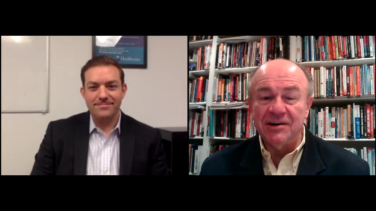The healthcare industry needs to stop using compliance and adherence as interchangeable terms. Compliance implies patients are just doing what the doctor told them. Adherence asks patients to come along on the journey so that they not only understand why they should take their medication, but also agree that it is what they should do. Laura Moore, EdD, CHES, Lead Health Psychology Specialist, Atlantis Healthcare, explains how health psychology can change patients’ belief systems and keep them adherent for the long haul—not just as long as you send text reminders or offer rewards. Even better, she offers a model that helps to personalize your approach for each patient. Contact Laura to learn more.
Laura Moore, EdD, CHES is Lead Health Psychology Specialist at Atlantis Healthcare. She has more than 20 years experience creating innovative health education initiatives targeting children and adults living with chronic illness. Her expertise is in combining a thorough understanding of psychosocial issues, health psychology models and epidemiology to build effective programs that promote behavior change.
Transcript
Bud Bilanich: Hi everybody. It’s Bud Bilanich, and I’m here with another edition of Experts on Call. And today, we have a great expert for you, Laura Moore, who works with Atlantis Healthcare. And they are basically a patient adherence company, and so this is something that you marketers out there need to pay some attention to because adherence is a big issue. So Laura, thank you so much for joining us today.
Laura Moore: Thanks for having me.
Bud Bilanich: Okay. So let’s talk a little bit about adherence and compliance, and I know that sometimes pharma brand managers sometimes confuse the two terms, and so let’s kind of start with the basics.
Laura Moore: Okay. That’s a great question, actually. When I first started a while back, often I’d go in talking about adherence, and I’d say “adherence,” and our counterpart would say “compliance.” And I’d say “adherence.” They’d say “compliance.” And finally, I thought, “We need to think a little bit about why we’re using these terms so differently.”
And I realized, in doing a little bit of research about it, that compliance is really more about a patient says, “Okay, I’m going to do what the doctors told me.” But in adherence, we’re really asking the patient to kind of come along on the journey. We want them to not just understand what they need to do but agree that this is the right thing that needs to happen. So it’s a really important piece to not just have a patient be compliant, that they’re doing what’s being asked of them, but that they agree that this is what they should be doing because that helps them feel a little more ownership and ultimately have better results.
Bud Bilanich: So I don’t just take my tablet or capsule every morning or every evening. I have an understanding of why I’m doing it and also some of the other things I may need to do from a lifestyle perspective that’ll help me in the management of my disease.
Laura Moore: Right. But even more than that, it’s that you agreed that you should be taking this in order to help whatever it is you’re trying to help. So your doctor told you to take it, but you’re not just going, “Okay, I’ll take it.” You’re saying, “You know what? I do think I need to be taking this. I agree with what he said. We’re kind of in the same place on this, and I’m going to take it because I’m in agreement with that, not just because he’s told me to.”
Bud Bilanich: Okay, so now –
Laura Moore: And then, yes, all those other reasons.
Bud Bilanich: Okay, so now we’re kind of almost getting into the psychology of this whole thing. It’s kind of like—it’s not like I’m doing it because I have to. I’m doing it because I want to.
Laura Moore: Right.
Bud Bilanich: Is that fair statement?
Laura Moore: Right. So we use health psychology approach a lot in how we work, and it’s important to use a lot of different models. We look at a lot of different ways, whether it’s contemplation, where someone is on a spectrum of they’re thinking about doing it, or they’re at the place of action where they feel like they should be doing it.
So we can kind of look at it that way, but we also look at it in terms of, “What are their underlying beliefs around it?” So are they having symptoms, which makes them believe they should be doing this? Has their doctor told them that, which made them start thinking about why this is important?
And then, you mentioned some of those other factors because no one lives in a bubble. So it’s important to think about what else is going in their lifestyle that may help the person kind of on this road with adherence or hold them back from being on the road to adherence. Are they very busy? Is it difficult for them to schedule taking their treatment? Is it hard for them to remember to do so?
And sometimes, memory—remembering isn’t just remembering, right? It can be—I call it “motivated forgetting.” Right? We forget because of some other reason. Are there some other things that may be holding them up? So it’s really, within health psychology, it’s really about looking at all of the beliefs that surround why someone may or may not be adherent with the medication.
Bud Bilanich: All right. So when you get into the whole idea of psychology of how one deals with their medication, does this work across diseases or across channels as you’re trying to communicate with patients? Or is it more channel specific or condition specific?
Laura Moore: Yeah, that’s a great question, and it absolutely works across different diagnostic categories. It works across treatment modalities. It works across age groups, and it works across whatever modality you want to use to transmit the information.
So the beauty of it is that you’re assessing not just a population as a whole, but you’re looking at the population sort of in general, and we’re looking at what, in that population, may be big factors that either improve adherence or could be barriers. And then, on a more individual, basic level, you’re looking at each of these individuals. What are some of those factors, and how can we help them think a little bit differently about them?
So it doesn’t matter what the problem is because you’re addressing them where they are with whatever the issue is that they’re having at that time, and it works. The techniques that we use to help them think a little bit differently work across all different kinds of channels. So whether that’s talking to someone, whether it’s a written exercise, whether it’s a messaging, or information-based, all of these techniques that we use to kind of help them think a little bit differently can be used in any of those channels.
Bud Bilanich: Well, that’s great. Now, I get it sort of from the physician perspective there, but we’re talking here to marketers. So if I am marketer, how can this be beneficial to me as I’m promoting my product?
Laura Moore: Well, right. So I kind of say the “half switches,” right? So when you think about it from a patient perspective—and that was my background initially—it’s sort of easy to understand why you want the patient to change their beliefs. And from the physician perspective, it’s helpful for them to understand what some of these belief categories are because that helps with a conversation you can then have with the patient, right?
So I know that for this category of patients, maybe treatment concerns are an issue, or maybe side effects are an issue or maybe not really understanding a disease because their newly diagnosed. So that helps me.
When you look at it from a pharma perspective, we go in. And really, what they’re looking for is persistency, right? On the pharma side, they want to see that patients are renewing their prescription as they’re supposed to be and taking their medication as they’re supposed to be, which then helps them with the refill.
So from the persistency point of view, you want to start, again, not at compliance but at adherence, having a patient really understand why they’re taking what they’re taking, agree that they should be taking it, and then addressing those underlying beliefs. Because once those beliefs are addressed, unlike kind of a quick solution like a points for prizes or just reminder messages, getting them to think about their beliefs and change how they think about those beliefs, we know that that lasts for a much longer time.
And we can see the results over a much longer time in terms of refills and persistency as opposed to stopping the reminders, and then they stop doing what they’re supposed to be doing. Getting them to have the ownership and bringing them on the journey really helps them to be responsible for and think about things differently, which, then encourages persistency over time.
Bud Bilanich: All right. Yeah. One of the other things, in your upcoming article, you talk about a model that you have. I believe you call it COM-B. Is that correct?
Laura Moore: Right. That’s correct. So the COM-B–
Bud Bilanich: Tell me a little bit more about that.
Laura Moore: Oh, sorry. I’m sorry.
Bud Bilanich: That’s okay.
Laura Moore: I was just going to say the COM-B—so the beauty of psychology is we’ve got plenty of theories to choose from when we’re talking about different things. So this is one model that we found kind of is a wonderful way to encapsulate all of those little pieces you mentioned earlier.
So in the COM-B, the B is “behavior,” which, in this case, obviously, is adherence, right? We want patients to be adherent. And then the COM kind of gives you three buckets to look at in terms of what are some of those factors that are driving adherence.
So the C is “capability,” and that’s kind of an easy one. Are the patients able to do what we’re asking them to do? So a good example of this is can they remember to take it?
And arthritis is a great example, right? So we were asking arthritic patients to open bottles to take capsules that they couldn’t open the bottle because they had arthritis. So that’s where the kind of those cool caps came from, the arthritis caps, right? And so that’s a great example of a patient being able to do something they need to do. Are they able to self-inject? So anything that relates to capability falls in that bucket.
The next bucket is “opportunity.” Do patients have the opportunity to do what they need to do to be adherent? So do they have an HCP that they can talk to on a regular basis and get questions answered? Are they able to get the drug? Or are they able to get the treatment that they need that we’re asking them to do? So whether that’s a cost barrier or having an access point, those types of things, those all fall into that bucket.
Third bucket, the bucket that we like to talk about the most because it’s where we can have the most impact is the M, which is “motivation.” So within that motivation bucket is where we look at things like beliefs. What does a patient believe about their illness? What does a patient believe about the treatment? What do they believe about potential side effects? What do they believe about quality of life or lifestyle factors? How do they believe this is going to impact them in other ways?
So as we start breaking down what some of those beliefs are—and we can do it kind of overall for the whole population and say, “These are the things based on this type of illness and this type of treatment that we can say would impact them.” Or we can do it on a more individual level and say, using a special tool, look at them and say kind of, “What are their beliefs in these big buckets?” And make them into smaller pieces.
So say for this patient, these three are the most important. So just because you and I have the same disease or the same chronic illness and you and I are taking the same medication doesn’t mean that what you think or believe is the same as what I believe. So what’s important to me may be different than what’s important to you.
And it’s super important, then, that within that M or that motivational bucket that we are addressing your needs to you and my needs to me. And that’s sort of the second piece of this, which is really getting into personalization and individualization. Since we’re each unique our response or are beliefs are going to be unique, and the response to those beliefs should be unique, as well.
Bud Bilanich: So you are helping move things along the curve here because everybody these days talks about the importance of being able to not just push product out there but to make sure that they’re involved with patient outcomes and give patients, I guess, the B, getting them to have the behavior that actually leads to adherence, as you described it before, wanting to actually participate with taking the medication and any other kind of lifestyle issues. So the whole capability, opportunity, and motivation that’s the COM.
And the M is what you guys think is the most important part of the COM-B model. It’s that motivation, which goes back to being individualized attention for patients.
Laura Moore: Right. And it’s really about how the beliefs can differ from person to person. Those beliefs are a huge driver. We know that based on the research that’s been done. So it’s really important to kind of address those issues in order to push people forward to the next point and bring them along on the journey with you, right?
It’s not sort of about being able to tell them what they should do. It’s helping them to think about it a little bit differently. We talk a lot about knowledge and people understanding things and knowing what to do, but I was joking. I say, “Well, I know how much water I should drink and what I’m supposed to be eating and how much sleep I should get,” but I don’t necessarily do any of those things perfectly every day, right?
Because if we did, we’d all walk around looking perfect in this kind of ideal world. So knowing it, that knowledge isn’t enough. It’s really understanding why my beliefs may be causing me to not drink eight ounces of water eight times a day.
Bud Bilanich: Well, you know, it’s very interesting. When I was a kid, my dad used to work for U.S. Steel, and every once in a while, he would show up with a pencil, and the pencils used to say, “Knowing is not enough,” and—
Laura Moore: Well, there you go. Exactly.
Bud Bilanich: One of the great mysteries of my childhood. What does this mean? And it actually comes from Goethe who said, “Knowing is not enough. We must do.” But you’re hinting at the same thing, that it’s one thing to have knowledge of your disease, and it’s a whole other thing to be willing to do what you need to do.
Laura Moore: Right. And then not just do it for the short term, but do it for the long run, right? Sometimes—everyone says getting started can be the hardest part, but oftentimes, getting started is the easiest point. So if you look at somebody who’s maybe been either newly diagnosed or had it for a while and they’re kind of anxious to feel better, you’re kind of quick to get on that.
Even something simple, like an ear infection, you’re quick to hop on an antibiotic and make the pain stop. But once that’s done in three or four days, what makes you finish taking all those doses? Right? I would say I’m the worst patient because I’m like, “Well, I feel better. Do I really need to be doing this?”
So what are those beliefs underlying it? Why wouldn’t it I finish it as it’s been prescribed to me? And it’s the same thing. So knowing it, understanding it, getting started with it, it’s not the same as being persistent over time. And really looking at those underlying beliefs and motivational factors is what helps us to be consistent and persistent over time.
Bud Bilanich: Yeah. I’m going to ask you one last question here.
Laura Moore: Sure.
Bud Bilanich: We’re talking personalization, and that’s great. But I’m a marketer, and I’m saying I have this huge population of patients. How can I possibly really make personalization actually work?
Laura Moore: Right. So that’s a great question, and I always say that there’s really two levels of personalization. So we can look at the disease as a whole, and we can look at the population who might be taking a certain treatment as a whole. And in those two buckets, we can come up with a pretty good idea of what the big-level beliefs might be. Is it treatment concern? Is it illness issues? What do we see in this population that makes us think, “Hmm, okay, these are the areas to focus”?
So anything that we do here at Atlantis, we always start with that research piece. We go back, and we look, and we do in-depth interviews, and we talk to patients, and we see what’s in the literature to see, really, what are those big buckets. And then, from there, we come up with a screener survey that allows the patients to go in individually and say, “Hmm, is this an issue for me or not? Is this an issue for me or not?”
And we use these validated questions. They look at these beliefs that have been kind of honed down from the bigger buckets and see how they do apply right to an individual for what their unique needs are.
And so I said earlier, you may have one thing, and I may think something else. But we may even say you and I both have same three top three concerns. Maybe number three is most important to me and number one is most important to you. So it’s kind of like starting from the bottom.
If you don’t hit those things that are the most important first, and you start with something that’s a little bit less important up the line, you’re kind of going to miss the underlying belief. And it’s very quick to turn someone off, and they’d be like, “Oh, this is important to me,” or, “Oh, this isn’t relevant to me.” And then, you’re kind of missing the opportunity for them down the road.
So that personalization and getting in at that basic screener level really allows you to look at what’s important to Person A and what’s important to Person B and then address the messages. Even though the messages might be similar in those buckets, the right person getting the right message at the right time in the right order, and that’s really how you do it.
Bud Bilanich: Well, I can see that this is something that you care about. It actually shows through.
Laura Moore: It is. It is. Oh, I’m glad.
Bud Bilanich: And so, now, it’s really—it’s actually very interesting what you’re saying here, and I really do think that readers of the magazine can benefit from this, and they really do need to take a closer look at your article and the COM-B model. So anything else we need to talk about before we say our farewells here?
Laura Moore: Yeah, I was going to say I think that was kind of everything in a nutshell, and I think what you said is perfect. It’s not just—what was that quote you used? It’s not just—understanding is not enough.
Bud Bilanich: Knowing is not enough.
Laura Moore: Yes, it’s not enough. Right? So it’s really kind of remembering that everyone’s unique and getting those underlying beliefs for long-term change. I’d say that’s really the key.
Bud Bilanich: Well, that’s—
Laura Moore: And bringing the patient on the journey. I think that’s my favorite part.
Bud Bilanich: Well, that’s great. You know we’ve been speaking with Laurie Moore—Laura Moore—excuse me—from Atlantis Healthcare, and we’ve been talking about adherence. And adherence is a good thing if you’re trying to sell products.
Laura Moore: It’s a good thing.
Bud Bilanich: So listen up brand managers. So thank you so much, Laura.
Laura Moore: Thank you.





